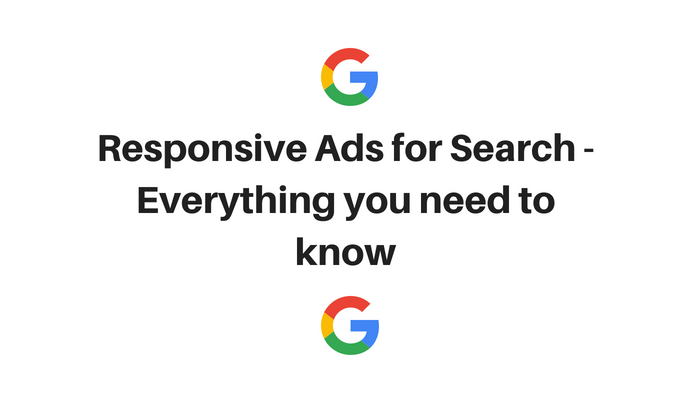The last articles I have devoted to the innovations from Google and this one is no exception. After the Keynote speech on Google ads few weeks ago more innovation was announced for advertisers. One of these innovations is Responsive Ads for Search. This ad type is not yet available for all advertisers, but is soon to become.
What are Responsive Ads for Search?
Earlier last year Google announced Responsive Ads for Display. These are go hand in hand with Google’s Smart Display campaigns – powered by machine learning, fully-automated campaigns. The creatives are a combination of text, images and logo which the advertiser uploads and Google takes care of the rest. By constantly rotating and trying the different text and image combinations, the ad-serving system picks the best performing ones and shows them programmatically to the right user at the right time.
The same concept is now taken to Google Search. Google Search advertising has allowed semi or fully-automated bidding with strategies like Target CPA, Target ROAS or Maximize Conversions. However, the ad creative process has always been manual and dependant on the advertisers’ patience and persistence to test and tweak ad copy. A lot of businesses are very reluctant to be experimental with ad copy of fear to expose their brand in a negative way.
Google Search Ads Updates Timeline
With series of updates Google has made it clear to advertisers that the quality and variety of ad copy they use is extremely important to the success of their campaigns. Consumers are more responsive to ads that are customised to their needs. Therefore, Google has been pushing advertisers to experiment more with ad copy.
In early 2017, the Expanded Text Ads (ETA) replaced the old text ads on Google Search. The ad copy requirement switched from one title and two description lines to two titles and one description. This is the time when the ad results on the right side of the search disappeared.
With the introduction of ETAs, Google started recommending at least 3 ad variations per ad group. By that time majority of the advertisers were running one ad per ad group except for tests and experiments.
In the spring of 2018 auto-suggested ads started popping in the Recommendations (former Opportunity) tab. These are variations of ads, combined with best performing extensions and landing page content. If the advertiser does not react to choose whether they pay or not, Google starts the auto-suggested ads automatically to run with the manually created ETAs in the account.
Another innovation in this area is the introduction of Dynamic Search ads. These are still ads in the ETA format, but the headlines and descriptions are automatically generated from popular landing pages and users’ searches.
Keyword insertion, as well as ad modifiers, countdowns, etc. are also ways to make the ad copy more responsive to the users’ search query. Google recommends the use of at least one ad with a keyword insertion or a modifier per ad group. This allows the ad-serving system to insert a keyword in the headline of the ad, based on what the user searched for. If there is not enough space, it will automatically insert a word you have specified. Also you can upload feed of product variations and characteristics, so that they automatically appear in the ad copy depending on what the user is looking for.
What are Responsive Ads for Search

The latest piece of this ad copy evolution is the RSA (Responsive Ads for Search). They consist of three headlines and two descriptions. As you can imagine this is a very large piece of real estate on the Search results page. To create a responsive ad, the advertiser must provide 3-15 variations of the headlines and 2-4 variations of the descriptions. These will be automatically rotated and combined by the ad-serving system to find out the best performing combination.
For many advertisers, this is a challenge like the one of Responsive Ads for Display and Dynamic Search Ads – no control on the appearance of the ad. Google is assuring that the algorithm will avoid redundant text side-by-side, but there is no way to really prove it. Advertisers cannot see in which form their ads have appeared and must trust the machine learning to choose the best combination.
It is possible to “pin” some of the Headlines (up to 2) to make sure they always appear as a first, second or third headline. However, the more restrictions you put on the campaign, the less value you can get out of the automated ad-serving. The pinning takes away the whole purpose of having a machine learning powered creative rotation.
Responsive ads for Search are still a BETA, so most advertisers have no access to them. However, they are expected to become available for everyone in the next few weeks. Google recommends starting with the new ad type cautiously by testing it on one campaign first.
Advertisers who have been using the BETA have so far reported relatively low impressions on the new ad type, although they have been increasing the more advertisers start using the new ad type.
Adopting a new ad type early always gives an opportunity to outperform other slower adopters and have more experience before it becomes mainstream. It has its risks as you act as a test rabbit for it. In some cases, it might not perform well, in others it might be outstanding or just as good as before. In any case adopting innovations early gives you opportunity to learn and be first in the direction of development of the sector. Having this experience gives you a step ahead when the change becomes widely adopted.

